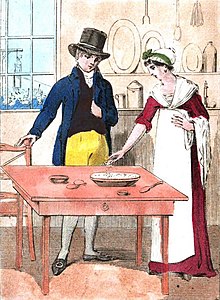Mary Bateman (1768 – 20 March 1809), also known as the Yorkshire Witch, was a poisoner and thief born in Asenby, Yorkshire.[1] Her most audacious deception was the creation in 1806 of the hoax known as The Prophet Hen of Leeds, which played on the fears of those who believed that the Second Coming of Christ was imminent.[2]
Mary was the daughter of a farmer, Benjamin Harker, and his wife Ann, née Dunning.[3] She received a relatively good education for a girl of her social standing, and was proficient at reading and writing. At the age of thirteen she was sent into domestic service at Thirsk, and seven years later moved to York, where she learned dressmaking. But after only a year she was forced to flee to Leeds after being discovered during a robbery. For the next three or four years she worked as a mantua maker,[a]A mantua is a fashionable ladies over-gown.[4] and began to supplement her income by telling fortunes and making love potions.[4]
Life of crime
Said to be “charismatic … charming and above all extremely adept at identifying the psychological weakness of the gullible”, Mary discovered that the poor and desperate of the industrial town of Leeds provided fertile ground for her schemes.[5] Although she was undoubtedly earning a good living from her magical activities, Mary displayed a “pathological need to steal.” She seems to have been none too careful to conceal her activities either, as she was caught several times, avoiding prosecution by buying off her victims. She married John Bateman, a wheelwright, in 1792, but there is no evidence that he was ever party to his wife’s robberies.[1]
The Prophet Hen of Leeds
In 1806 Mary saw an opportunity to exploit the growing popularity of the self-proclaimed prophetess Joanna Southcott, who preached that the end of the world was approaching, and that Jesus Christ would be returning imminently. Joanna’s followers, known as Southcottians, were said to number in excess of 100,000, and Mary decided to become one of them. Joanna had in 1702 begun giving her followers a special token, to mark them out as one of the 144,000 who would be saved according to the Biblical Book of Revelation, and Mary, by whatever means, managed to get hold of one.[6] Like many housewives of the period she kept hens, and she reinforced her standing as one of those to be saved by announcing that one of them had laid a miraculous egg bearing the inscription “Crist is coming”. She further announced that the bird would lay thirteen more such eggs, the last of which would mark the beginning of the Apocalypse. Mary charged between a penny and a shilling each to the thousands who came to see the miraculous bird,[b]A shilling would be equivalent to about £4 as at 2019, using the retail price index.[7] and began selling her own version of Joanna’s seal, guaranteeing the purchaser entry into heaven.[8]
Mary’s fraud was exposed by a suspicious local doctor, who while spying on her early one morning observed her etching the words into a newly laid egg with acid. He alerted the authorities, who discovered her in the act of reinserting the egg into the hen’s oviduct, to be laid again later. Mary appears to have avoided any punishment however, there being no police force in the modern sense in Yorkshire until the 1830s, but it did put an end to her hoax.[9]
Downfall
Mary’s downfall came in October 1808, after a Leeds clothier named William Perigo accused her of murdering his wife, Rebecca, by poisoning.[1] Rebecca had begun to suffer from “chest palpitations” whenever she laid down, and been told by her physician, Dr Curzley, that was under some kind of spell, an “evil wish”. Rebecca’s niece suggested that Mary might be able to help.[10] After defrauding the Perigos of a great deal of cash and goods in return for her “help”, Mary decided that they had to be eliminated, either because they were running out of cash or she felt they were becoming suspicious, and so she provided Rebecca with six packets of poisoned powder, one to be mixed each day with their puddings, with strict instructions that the puddings should only be eaten by the Perigos themselves. Thus the couple conveniently poisoned themselves, and Rebecca died on 24 May 1807; William survived because he found the taste of the powder so foul that he did not eat as much of it as his wife.[11]
Mary was tried at the York assizes in March 1809 and found guilty of wilful murder.[1] She was sentenced to be hanged and her body given to surgeons to be dissected; the sentence was carried out the following Monday, 20 March.[12]
Aftermath
Mary’s body was taken to Leeds General Infirmary, where it was put on display. Visitors were charged threepence admission to see it, from which the hospital raised about £30.[13] Tickets were also sold to spectators to watch her dissection, which raised another £80 14s, equivalent to about £5,900 as at 2019.[14][c]Using the retail price index.[7]
Two books were commissioned to be covered in Mary’s skin, a practice known as anthropodermic bibliopegy: Sir John Cheek’s Hurt of Sedition: How Grievous it is to a Common Welth (1569), and Richard Braithwaite’s Arcadian Princess (1635), now both lost. Small strips of Mary’s skin were sold as curios, and acquired a reputation for having the power to ward off evil spirits.[15]
Mary’s skeleton was on display in the Thackray Museum in Leeds until 2015, but changing public attitudes led to it being returned to Leeds University’s Anatomy Department, where it remains in storage.[16]

